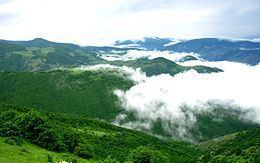Time zone IRST (UTC+3:30) | ||
 | ||
Khoda Afarin County (Persian: شهرستان خداآفرین) is a county in East Azerbaijan Province in Iran. The capital of the county is Khomarlu. At the 2006 census, the county's population was 34,461, in 7,492 families. The county is subdivided into three districts: the Central District, Minjavan District, and Garamduz District. The county has one city: Khomarlu. Until 2011, The county was a district of Kaleybar county. Before the Islamic Revolution, Khomarlu was merely a village which was distinguished from other villages for housing the headquarters of Royal Gendarmery. The notary office was located in Abbasabad village and operated by a cleric, who also acted as the spiritual authority of the whole district.
Contents
- Map of Khoda Afarin County Iran
- Economy
- Language
- Historical sites
- Khoda Afarin county and Ashugh music
- References
Map of Khoda Afarin County, Iran
Economy
Before the Islamic Revolution of 1978, then a district of Ahar County, had a dynamic economy; the surplus agricultural products from fertile farmlands along Aras were exported to Ahar, and on the lush uplands large herds of sheep was a common sight. Of course, since the turbulent days of Azerbaijan Democratic Government, some residents were travelling to Tehran or Tabriz for seasonal work on construction projects, and by the late 1970s some of these migrant workers were established contractors. Accordingly, majority of active male population was spending half of the year in cities. The Islamic Revolution drastically changed social order. In the 1978–1979 period many of the migrant workers in Tehran constructed illegal dwellings on government lands at the North-East of Tehran and moved their families to the city. During the second big migration wave of the 1990s, most villages of the county were evacuated and residents settled in the shanty-towns at the South-West of Tehran. In recent years, some expatriates have returned and constructed decent houses. The county is already experiencing a construction boom. This has rapidly increased demand for construction workers. Moreover, the capital inflow to the county in anticipation of potential boom in Eco-tourism has resulted in launching many projects related to hotels and campgrounds.
Language
The spoken language is the Azerbaijani Until the 1970s some elders in four villages (Chay Kandi, Kalasor, Khoynarood, and Arazin) could communicate in Tati. The mountainous terrain, shepherding and cultivation of hillsides possess the isolating features for the development of a sophisticated whistled language. The inhabitants of the region employ the fingered whistle format for long range communication. More importantly, the majority of males are able, and perhaps addicted, to masterfully mimic the melodic sounds of musical instruments using fingerless whistle. Melodic whistling, indeed, appears to be a private version of the Ashug music for personal satisfaction.
Historical sites
Khoda Afarin county, and Ashugh music
The county has been known as the epicenter of Arasbaran school of Ashugh music. The mountainous terrain, and the socio-cultural upheavals of the past two centuries have given a characteristic melancholic feature to the songs composed by the rebel-poets originating from the region. A revealing example is a song which was composed by Bahman Zamani following the tragic drowning of Samad Behrangi in Aras.
If, the mighty mountains can boast their height again,
If the crystal-clear water can irrigate the slopes again,
If, again, the ripen fruits can bent green branches,
Then, who says that my melodic words will not outlive me?
Two living masters of Ashugh music, Changiz Mehdipour and Rasool Qorbani, were born in Khoda Afarin county. In addition, many inhabitants, particularly the second generation immigrants living in Tehran, play Kopuz as a manifestation of their long denied cultural identity.
